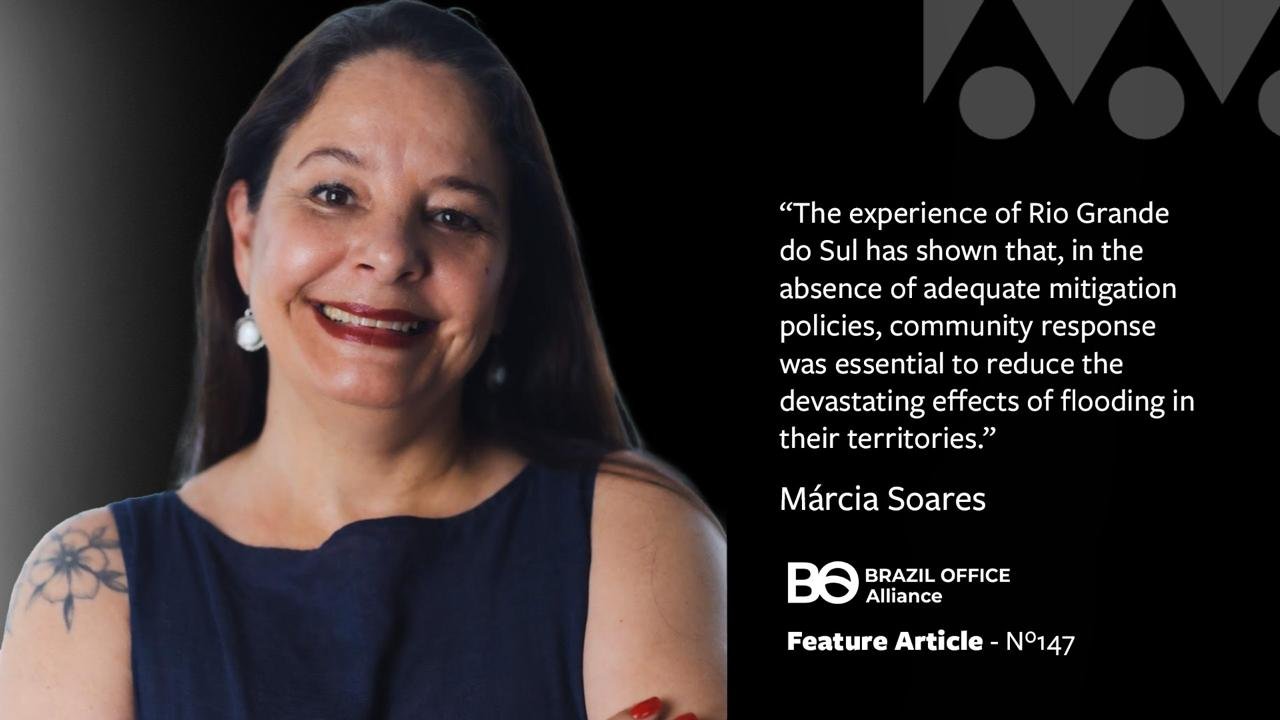The Inequalities of Climate Disasters: Talking about Gender and Race
Márcia Soares is executive director of Themis – Gender Justice and Human Rights, a feminist and anti-racist organization that has been working for 31 years to expand women's access to justice. This article was written for the 147th edition of the WBO weekly bulletin, published on December 13, 2024. To subscribe to the bulletin and receive it for free, enter your email in the field provided.
Climate disasters have become increasingly frequent, affecting entire communities. However, this crisis does not affect everyone equally, as we saw recently in the floods that devastated Rio Grande do Sul. The reality is that impoverished women, especially Black women, are the most impacted.
Often, people living in outlying regions are the ones most at risk of exposure to the effects of extreme climate events. They are also heads of households in poverty-stricken contexts who face additional challenges due to the violations of their rights, which are intensified in crisis situations.
The report, “The Gender Dimension in the Big Push for Sustainability in Brazil: Women in the Context of the Social and Ecological Transformation of the Brazilian Economy,” produced by UN Women Brazil, is categorical in pointing out that the lack of effective actions in the face of the climate emergency disproportionately impacts women, girls, and feminized bodies, given that they start from a situation of profound structural inequalities.
The document shows that Black, Indigenous, quilombola, peripheral, poor women, and feminized bodies are groups especially exposed to the impacts of climate inaction, which highlights environmental racism. Furthermore, the context of profound structural inequalities, the increased frequency and intensity of extreme climate events – such as prolonged droughts, floods, storms, landslides, peaks of heat and cold, etc. – makes women more exposed to adversity than men. And this leads to the obvious: women in conditions of greater socioeconomic vulnerability tend to have fewer tools to face the impacts of climate change, given the gaps in wages, jobs, access to public goods and services, representation, and rights.
A crisis situation reproduces and increases social inequalities, where two issues are especially important to consider. One of them concerns the possibility of violation of the bodies of women and girls. The threat of sexual violence is constant, whether at the time of rescue or in the situation of compulsory shelter. In Rio Grande do Sul, there were numerous reports of the abuse of children and adolescents and attempted rape in temporary housing. Another issue concerns care work, which has historically been reserved for women. It is their responsibility to care for children, the elderly, and the sick in absolutely adverse conditions, when these people are without food, medicine and, often, without access to drinking water. All of this is compounded by the lack of referral services. Furthermore, many of these people are already at their physical, psychological and emotional limit and have fewer tools and income to deal with the consequences of disasters.
And while, on the one hand, they are more susceptible to the consequences of these events, on the other, the inequality in the emergency response by the government is evident. The attention and mitigation of the consequences of the crisis disregard – or do not prioritize – the needs of women and children. In addition to the invisibility to which this population has historically been subjected, there is another factor that must be considered: the lack of access for women to decision-making spaces and the formulation of policies to reduce these impacts: emergency strategies and actions are usually defined by predominantly male groups (see the majority composition of the so-called crisis committees, in the case of Rio Grande do Sul). The lack of security in shelters, the lack of safe spaces for children, and the absence of broader public policies aimed at women expose a critical flaw in the response to these emergencies.
Another issue that draws attention is the data gap with gender and race indicators. The Technical Note from the Institute of Applied Economic Research (IPEA) titled “An Estimate of the Population Affected by the Floods of Rio Grande do Sul in 2024,” from September 2024, indicates that the state of Rio Grande do Sul had 581,643 displaced people and 65,762 people in shelters during the flood. How many of them are women? How many are Black? How many are Indigenous? These are questions that we cannot answer.
The experience of Rio Grande do Sul has shown that, in the absence of adequate mitigation policies, community response was essential to reduce the devastating effects of flooding in their territories. When the government fails to provide adequate support, community leaders emerge to mobilize resources, solidarity, and care. Civil society organizations also played a crucial role in this process, not only in humanitarian aid, but also in disseminating information and supporting leaders so that they could act more effectively and safely.
In this new climate context, it is essential to rethink how disaster responses are structured, in order to prioritize the inclusion of women and their communities in discussions and in defining priority actions for preventing, mitigating, and repairing the impacts of these events. This is essential if we are to move towards a response model that not only mitigates damage, but also prevents new events from occurring in the most vulnerable territories.


